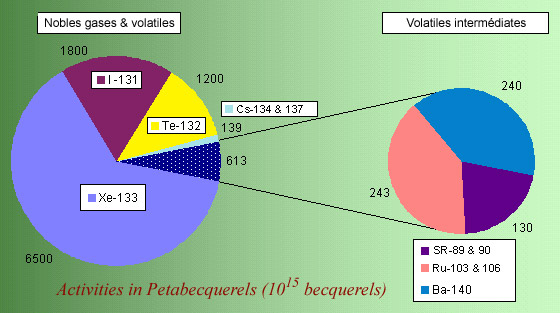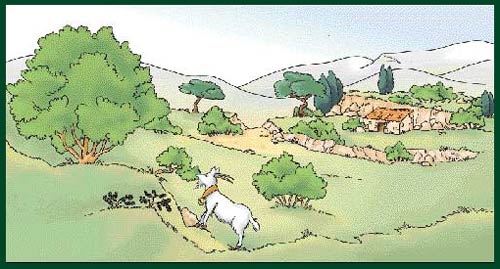Risks and exposition sources after a major accident
The main sources of exposure following an accident with a major release of radioactive material are : cloud irradiation due to the radioactive cloud, inhalation of radioactive particles, skin and clothes contaminations, radioactivity deposits on ground and contaminated food and water.
The exposure due to the radioactive cloud is an external irradiation from a distant source of gamma rays. When the radioactive material is released as a result of an explosion, the cloud formed from the initial plume is blown and carried away by the winds.

Inventory of Chernobyl releases
Volatile and short-lived radioelements have contributed most to the initial activity dispersed during the Chernobyl accident, mainly xenon-133 and iodine-131, as shown by this inventory of realeased activities. Xenon-133, a noble gas source only of external exposure, is less dangerous than the radioactive isotopes of iodine that reach the thyroid through the food chain (especially milk). During the first weeks and months, activity decreases greatly forshort-lived elements until longer-lived elements such as cesium become predominant.
© IN2P3 (Atlas of Tchernobyl)
It is dangerous in the early days because of the predominance of very radioactive elements. Rapidly the decay with time and the dilution in the atmosphere diminish its importance. At Chernobyl, shortly after the explosion, xenon-133 was the most active element, followed by iodine-131. Xenon is a noble gas, not very toxic because it can not be assimilated by living organisms. It disperses quickly.
Although the air offers a poor protection, the irradiation by the cloud is attenuated by the distance depending on its altitude. In the example of gamma of 1 MeV of energy, only one of 1000 such gamma escapes interaction with the air atoms every 900 meters.
Inhalation of radioactivity may be potentially more dangerous. It is due first to the radioactive aerosols coming from the cloud during its passage, and later on to dusts resuspended.
Contamination of the skin and clothing occurs mainly during the first interventions and among the persons working on the contaminated sites. Like inhalation of radioactivity, it occurs during the passage of the cloud and later on by the resuspension of radioactive dust or the handling of contaminated materials.
Ground deposits of radioactive isotopes on the ground is the source of external gamma irradiation. Less intense than that of the cloud, it is short range and of long duration. In the first few weeks, it is mainly due to short-lived radioactive isotopes such as iodine-131. At the level of several years, caesium-137 dominates.

Example of food chain
The contamination in may 1986 of goat cheese in Corsica mountains was an example of penetration of the food chain by radioactive atoms, either through inhalation or by deposits on the vegetation. Some Mediterranean plants, such as thyme or dried fruits, contain more radioactive elements, as their water content is low. The goats feed on these plants. For their milk, more mineralized than cow’s milk, peak levels of iodine-131 contamination up to 15000 becquerels per liter were observed. However, this milk did not enter the diet of very young children most sensitive to this contamination divided by 2 every 8 days.
© IRSN/Martine Beugin
Ingestion of contaminated food and water is the source of internal exposures. The contamination comes mainly from iodine-131 in the first weeks and then from cesium-137 when time has done its work. These two isotopes, absorbed by plants, penetrate the food chain.